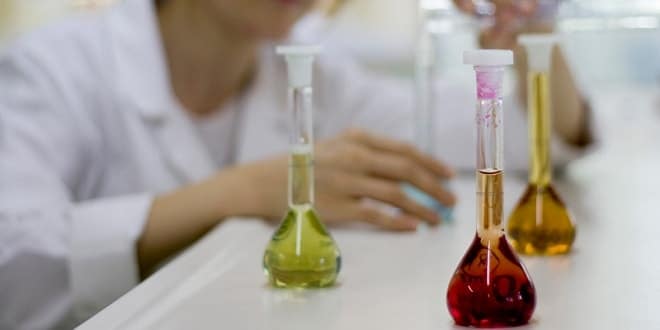Gıda Kalite Kontrol
-

Laboratory > Analysis of Wheat Flour ( Ahmet DEMİRCAN )
FE 376 FOOD QUALITY CONTROL ANALYSIS OF WHEAT FLOUR Submitted to: Emine ERÇELEBİ Submitted by: Ahmet DEMİRCAN PURPOSE: The aim of this experiment was to consider the standard content of flour by doing main analysis. THEORY: Wheat quality and methods in wheat quality determination is important. Determination of the quality of bakery products which have significant position in the food industry and nutrition is necessary from the point of product features and economic view. However, the choosing appropriate raw material according to that appropriate quality of wheat/flour/semolina is very important…
-

Laboratory > Fats & Oils
Purpose: In this experiment we tried to analyze fats and oil to observe some quality parameters and interpreted the some differences between each other. Theory: The primary focus of the fats and oils laboratories is on value-added products resulting in cost effective oilseed processes, feedstocks and product performance in the marketplace. In addition, basic chemical analysis procedures and methodologies are applicable to other food, feed and nonfood compositions. The analytical laboratory is equipped with both instrumental and wet chemistry applications suitable for defining physical and chemical characterization of fat and…
-

Laboratory > Milk
PURPOSE Investigation of different types of drinking milk samples found in market in order to determine their qualities by comparing the results with TSE standards. THEORY Milk, liquid secreted by the mammary glands of female mammals as food for their young. The milk of the cow is most widely used by humans, but the milk of the mare, goat, ewe, buffalo, camel, ass, zebra, reindeer, llama, and yak is also used. The composition of milk varies with the species, breed, feed, and condition of the animal. Milk, an almost…
-

Laboratory > Pre lab questions and answers
PRE-LAB QUESTIONS OF FLOUR PRE-LAB QUESTIONS FRUIT PRODUCT PRE-LAB QUESTIONS OF MEAT PRE-LAB QUESTIONS OF MILK PRE-LAB QUESTIONS OF TOMATE PASTE OLIVE OIL – GROUP …
-

Sensory Analysis ( Betül ÖZDEMİR )
T.C. UNIVERSITY OF GAZİANTEP FACULTY OF ENGINEERING DEPARTMENT OF FOOD ENGINEERING FE 376 FOOD QUALITY CONTROL LABORATORY Experiment Name: “Sensory Analysis” Submitted to: Asst.Prof.Dr. ÇİĞDEM ( AYKAÇ ) SOYSAL Submitted by: Betül ÖZDEMİR Başak Koç Hüsamettin KİRAZ Mustafa MUTLU PURPOSE The purpose of this experiment was application of triangle test for different kind of yogurt to find out a detectable difference between two similar yogurt. THEORY Sensory analysis (or sensory evaluation) is a scientific discipline that applies principles of experimental design and statistical analysis to the use of human senses (sight, smell, taste, touch and hearing )for…
-

Laboratory > Tomato Paste
PURPOSE: The aim of this experiment is determination of Black point, Sugar content, Color, Total soluble solids, Acidity, and Salt of tomato paste, and discussing our results. MATERIALS: Glasses, Refract meter, Funnel, Filter paper, Pipette, Burette, Beaker, Flask, Hunter lab, Bunsen burner, THEORY: The tomato is an extremely valuable raw material for a very wide range of processed foods and the demand by the food industries of the world for tomatoes continues at high level. The conversion of tomatoes into tomato paste will be examined in considerable details as this…
-

Licorice Syrup
FE 376 FOOD QUALITY CONTROL LICORICE SYRUP Licorice is the root of glycyrrhiza glabra from which a somewhat sweet flavor can be extracted. The licorice plant is a legume that is native to Southern Europe and parts of Asia. It is not botanically related to anise, star anise, or fennel, which are sources of similar flavouring compounds. The licorice plant is part of the pea family and is found in Turkey and Greece, although it is propagated in many parts of the world. This herb contains FLOW CHART OF LICORICE…
-

Mekanik Ayırma Ekipmanları
Mekanik Ayırma Ekipmanları V. GIDAYLA İLİŞKİLİ KISIMLARIN AYRILMASI 1.Genel Görünüşler Ayırma işlemleri katı ve sıvı işlemler olarak da sınıflandırılabilir( Tablo 5-1).Katı gıda maddesinin veya özünün ayrılmasında, iki alt kategori ürüne özgü kısımları ayrılması( ör: kiraz sapları veya kiraz çekirdekleri ) ve ürünle ilişkisi olmayan( yabancı ) kısımların ayrılmasıdır(ör: toz, böcekler ).Bundan başka, ürüne özgü kısımlar iç( ör: kiraz çekirdekleri, kemikler ) veya dış( ör: kiraz sapları, hayvan derisi ) olabilir.Ürüne özgü kısımların ayrılması işlemindeki amaç ayrılmış maddeleri ya da özleri(ör: meyveden meyve suyu ,şeker pancarından şeker eldesi ) almaktır veya…








